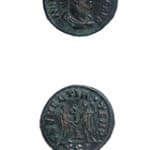Bronze Antoninianus of Carinus Struck While Caesar, 282 CE - 283 CE
Bronze
C.7015
Further images
Obverse: M AVR CARINVS NOB CAES; Radiate and Cuirassed Bust of Carinus Facing Righ Reverse: CLEMENTIA TEMP; Carinus, Standing on the Left, Holding a Baton, Receiving Victory on a Globe...
Obverse: M AVR CARINVS NOB CAES; Radiate and Cuirassed Bust of Carinus Facing Righ
Reverse: CLEMENTIA TEMP; Carinus, Standing on the Left, Holding a Baton, Receiving Victory on a Globe from Jupiter, Standing on the Right, Holding a Sceptre
Carinus was living in Rome at the time of his father Carus’ death while campaigning in Persia and was quickly elevated to Emperor of the West in 283 A.D. After his brother Numerian completed the Persian Wars, great triumphal celebrations were planned in Rome. However, these games were cancelled after Numerian was murdered and Diocletian usurped the throne. While Carinus was well liked by the people, he was despised by the Senate and the aristocracy for his life of debauchery, including marrying nine wives. At one point, he even threatened to seize the Senates vast estates and redistribute them among his people. With Diocletian approaching, Carinus gathered an army and defeated him in a decisive battle in the Margus Valley in April of 285 A.D. However, before his forces could pursue the fleeing Diocletian, Carinus was murdered by one of his own officers whose wife he had seduced. Thus, Diocletian rose to the throne uncontested and would go on to introduce far-reaching reforms that would change Roman society forever.
How many hands have touched a coin in your pocket or purse? What eras and lands have the coin traversed on its journey into our possession? As we reach into our pockets to pull out some change, we rarely hesitate to think of who might have touched the coin before us, or where the coin will venture to after it leaves our hands. More than money, coins are a symbol of the state that struck them, of a specific time and location, whether contemporary currencies or artifacts of a long forgotten empire. This stunning hand-struck coin reveals an expertise of craftsmanship and intricate sculptural detail that is often lacking in contemporary machine-made currencies. This ancient coin is a memorial to an emperor’s reign passed from the hands of civilization to civilization, from generation to generation that still appears as vibrant today as the day it was struck.
Reverse: CLEMENTIA TEMP; Carinus, Standing on the Left, Holding a Baton, Receiving Victory on a Globe from Jupiter, Standing on the Right, Holding a Sceptre
Carinus was living in Rome at the time of his father Carus’ death while campaigning in Persia and was quickly elevated to Emperor of the West in 283 A.D. After his brother Numerian completed the Persian Wars, great triumphal celebrations were planned in Rome. However, these games were cancelled after Numerian was murdered and Diocletian usurped the throne. While Carinus was well liked by the people, he was despised by the Senate and the aristocracy for his life of debauchery, including marrying nine wives. At one point, he even threatened to seize the Senates vast estates and redistribute them among his people. With Diocletian approaching, Carinus gathered an army and defeated him in a decisive battle in the Margus Valley in April of 285 A.D. However, before his forces could pursue the fleeing Diocletian, Carinus was murdered by one of his own officers whose wife he had seduced. Thus, Diocletian rose to the throne uncontested and would go on to introduce far-reaching reforms that would change Roman society forever.
How many hands have touched a coin in your pocket or purse? What eras and lands have the coin traversed on its journey into our possession? As we reach into our pockets to pull out some change, we rarely hesitate to think of who might have touched the coin before us, or where the coin will venture to after it leaves our hands. More than money, coins are a symbol of the state that struck them, of a specific time and location, whether contemporary currencies or artifacts of a long forgotten empire. This stunning hand-struck coin reveals an expertise of craftsmanship and intricate sculptural detail that is often lacking in contemporary machine-made currencies. This ancient coin is a memorial to an emperor’s reign passed from the hands of civilization to civilization, from generation to generation that still appears as vibrant today as the day it was struck.





